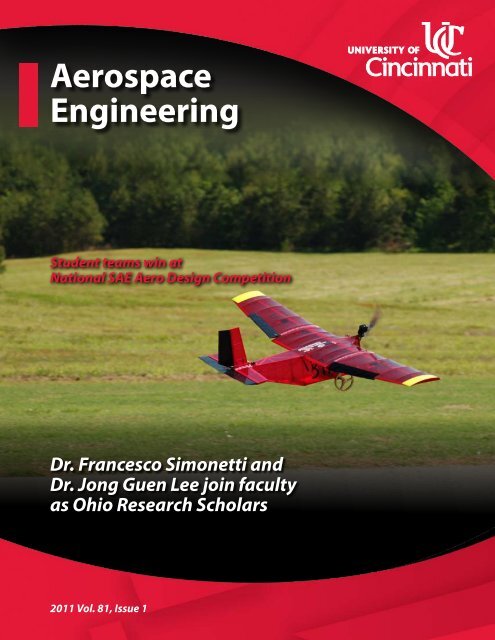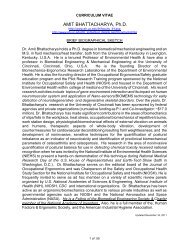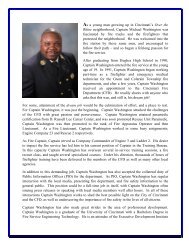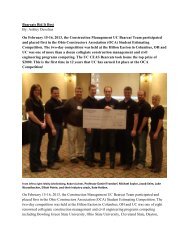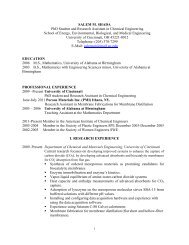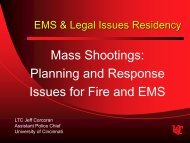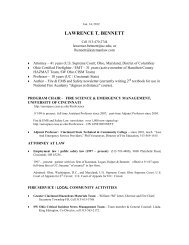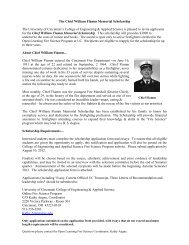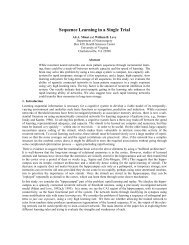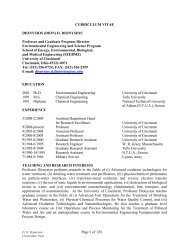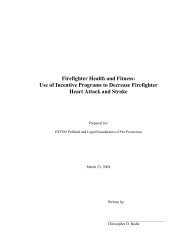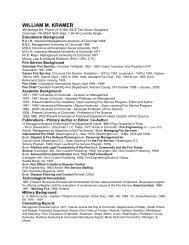2011 Newsletter - University of Cincinnati
2011 Newsletter - University of Cincinnati
2011 Newsletter - University of Cincinnati
You also want an ePaper? Increase the reach of your titles
YUMPU automatically turns print PDFs into web optimized ePapers that Google loves.
Aerospace<br />
Engineering<br />
Student teams win at<br />
National SAE Aero Design Competition<br />
Dr. Francesco Simonetti and<br />
Dr. Jong Guen Lee join faculty<br />
as Ohio Research Scholars<br />
<strong>2011</strong> Vol. 81, Issue 1
School <strong>of</strong> Aerospace Systems<br />
Department News<br />
3 Letter from the School Director<br />
4 Spotlight: Ohio Research Scholars<br />
5 Mark Turner recognized as an ASME Fellow, receives Young Researcher Award<br />
5 Peter Nagy publishes new text<br />
5 Kelly Cohen shares expertise with high school students<br />
6 Russell DiMicco retires<br />
6 Grant Schaffner receives Doc Counsilman Science Award<br />
7 Space Shuttle Symposium — “The End <strong>of</strong> a Love Affair”<br />
Student News<br />
8 Student Spotlight - SAE Aero East Competition<br />
9 Danielle Grage wins Herman Schneider Award<br />
10 Student Awards<br />
10 Aerospace welcomes National Merit Scholars<br />
Alumni News<br />
10 Thomas Byar recognized as UC Life Benefactor<br />
11 Class <strong>of</strong> 1961 reunion<br />
11 Alum notes<br />
Contact Us<br />
<strong>University</strong> <strong>of</strong> <strong>Cincinnati</strong><br />
College <strong>of</strong> Engineering and Applied Science<br />
School <strong>of</strong> Aerospace Systems<br />
P.O. Box 210070<br />
<strong>Cincinnati</strong>, OH 45221-0070<br />
513-556-3548<br />
aerospace.ceas.uc.edu<br />
On the cover — winning student entry in the National<br />
SAE Aero Design East competition, micro class division<br />
College <strong>of</strong> Engineering<br />
& Applied Science
Letter from the School Director<br />
I am glad to share exciting news <strong>of</strong> our students, faculty and alumni from the past<br />
academic year. We are very proud <strong>of</strong> our two Aerocat teams who won first place<br />
in both regular and micro class entries in the SAE Aero Design East competition<br />
in Marietta, Georgia on May 1. In the regular class, the senior Aerospace team<br />
surpassed a 25-year competition record for most payload ever carried. Their ability<br />
to recover from a near disastrous crash and to miraculously rebuild their aircraft in<br />
45 minutes is a reflection <strong>of</strong> their excellent teamwork skills, sheer determination, and<br />
all the attributes needed to excel in their future careers. For the second time in three<br />
years, one <strong>of</strong> our seniors, Danielle Grage, won the CEAS Herman Schneider Award<br />
for her exemplary co-op experience. We look forward to continuing our student<br />
successes in the future, with four national merit scholars in our largest ever first-year<br />
class this fall.<br />
The class <strong>of</strong> ’61 had a very busy 50th anniversary reunion led by Frank Tepe.<br />
Thomas Byar, class <strong>of</strong> 1959, was recognized by UC President Williams and UC Board <strong>of</strong> Trustees Chair Sandra Heimann<br />
as a Life Benefactor in recognition <strong>of</strong> his generous support <strong>of</strong> the Knowlson and Irene Byar Endowed Scholarship in<br />
Aerospace Engineering.<br />
Our Center for Intelligent Propulsion Systems and Advanced Life Management is now<br />
I mpressed by both student<br />
and faculty achievements,<br />
our Advisory Board would<br />
like to urge all alumni and<br />
friends to help identify co-op<br />
opportunities for our growing<br />
body <strong>of</strong> outstanding students.<br />
a reality with the two outstanding faculty, Pr<strong>of</strong>essors J. G. Lee and Francesco Simonetti,<br />
who joined UC as Ohio Research Scholars. Dr. Lee’s research focuses on combustion and<br />
propulsion in air-breathing and rocket propulsion systems. Dr. Simonetti’s research focuses<br />
on both theoretical and experimental aspects <strong>of</strong> wave mechanics for subsurface sensing and<br />
super-resolution imaging.<br />
Our Advisory Board met in May to review the Aerospace Engineering strategic plans<br />
and accomplishments, evaluate the Senior Design Team presentations and have lunch<br />
with the students. They were very impressed by both student and faculty achievements<br />
and would like to urge all alumni and friends to help identify co-op opportunities for our<br />
growing body <strong>of</strong> outstanding students.<br />
Aerospace Department Advisory Board (Spring <strong>2011</strong>)<br />
From left to right: Dr.Christopher Lorence, GE Aviation; Dr. Baily Vittal, Liberty Works, Rolls-Royce North American Technologies; Dr. Jack<br />
Benek, AFRL/WPAFB; Dr. Mike Heil, Ohio Aerospace Institute; Dr. Ronnie Miller, PAC/MISTRAS; Dr. Carol Russo, NASA Ames Research<br />
Center; Dr. Tom Wakeman, Belcan Corporation; Dr. Ajay Kumar, NASA Langley Research Center; Dr. Joe Shang, Wright State <strong>University</strong>;<br />
Dr. Eric Baumgartner, Ohio Northern <strong>University</strong>
D E p A r t m E n t S p o t l i g h t<br />
Ohio Research Scholars join the<br />
School <strong>of</strong> Aerospace System<br />
“The Ohio Research Scholars Program (ORSP), in partnership with the Ohio Board <strong>of</strong> Regents, was designed to attract<br />
leading research talent that can contribute to the growth <strong>of</strong> research centers <strong>of</strong> excellence within Ohio’s academic<br />
institutions that support economic development priorities <strong>of</strong> the state. The goal <strong>of</strong> the ORSP is to strengthen and increase<br />
the number <strong>of</strong> clusters <strong>of</strong> research excellence by 1) investing in the attraction <strong>of</strong> senior research talent and related facilities<br />
and equipment, and 2) promoting unique collaborations with nonpr<strong>of</strong>it and for-pr<strong>of</strong>it research and commercialization<br />
partners needed to build and sustain scientifically and commercially promising lines <strong>of</strong> research.”<br />
The College <strong>of</strong> Engineering and Applied Science’s School <strong>of</strong> Aerospace Systems is proud to have Dr. Jong Guen Lee and<br />
Dr. Francesco Simonetti as new Ohio Research Scholars.<br />
Dr. Lee’s research focuses<br />
on combustion and<br />
propulsion problems in<br />
air-breathing and rocket<br />
propulsion systems. He has<br />
many years <strong>of</strong> experience<br />
in combustion dynamics<br />
in gas turbine, ramjet and<br />
augmentor, development <strong>of</strong><br />
various laser-based optical<br />
diagnostic techniques with<br />
applications to propulsion<br />
systems, combustion<br />
control and sensors<br />
monitoring the combustion<br />
process, turbulent flame propagations and multi-phase combustion<br />
processes. He has been collaborating with many major gas turbine/<br />
aircraft industries such as GE Aviation, GE Energy, Pratt and Whitney,<br />
Siemens-Westinghouse, Solar Turbines as well as the NASA-GRC and<br />
DOE NETL (Natural Energy Technology Laboratory, Morgantown, West<br />
Virginia) in those areas. His research interests also include supersonic<br />
combustion, plasma-aided combustion, solid-propellants and<br />
combustion <strong>of</strong> alternative fuels.<br />
Dr. Lee comes to <strong>University</strong> <strong>of</strong> <strong>Cincinnati</strong> from the Pennsylvania State<br />
<strong>University</strong> where he has been a senior researcher in the Department<br />
<strong>of</strong> Mechanical Engineering. His research at UC will continue to be<br />
focused on Combustion/ Propulsion/ Energy Systems. His laboratory<br />
is now being established and equipped with state-<strong>of</strong>-the-art<br />
optical diagnostic instrumentation enabling Planar Laser Induced<br />
Fluorescence, Time-resolved Spectroscopy, High Speed Imaging,<br />
Spray Characterization, Fuel/air Mixing Measurement, Infrared<br />
Absorption, etc.<br />
4 | <strong>University</strong> <strong>of</strong> <strong>Cincinnati</strong>, College <strong>of</strong> Engineering and Applied Science<br />
Dr. Simonetti’s research lies<br />
at the interface between<br />
engineering, physics, and<br />
applied mathematics.<br />
He has made significant<br />
contributions to both<br />
theoretical and experimental<br />
aspects <strong>of</strong> wave mechanics<br />
for sub-surface sensing,<br />
including pioneering<br />
work on super-resolution<br />
imaging. His research<br />
has been underpinned<br />
by close collaboration<br />
with a wide spectrum<br />
<strong>of</strong> industries through his active participation in the UK Research<br />
Centre in Nondestructive Evaluation (NDE). As a Fellow <strong>of</strong> the UK<br />
Royal Academy <strong>of</strong> Engineering and a Faculty Affiliate <strong>of</strong> Los Alamos<br />
National Laboratory, Dr. Simonetti has made significant contributions<br />
to ultrasonic and electromagnetic materials characterization, flaw<br />
detection, diagnostics, and health monitoring applications. Dr.<br />
Simonetti has now established the Ultrasonic Imaging Laboratory at<br />
UC. Covering an area <strong>of</strong> 1200 sq. ft., the lab is equipped with state-<strong>of</strong>the-art<br />
technology for basic and applied research, including ultrasonic<br />
microscopes, 128-channel programmable array controllers, laser<br />
interferometers, and high-resolution infrared cameras. The mission <strong>of</strong><br />
the lab is to develop the next-generation sensing technology that will<br />
lead to novel industrial applications. These encompass life extension<br />
technologies, and life cycle management and prognostics <strong>of</strong> complex<br />
engineering systems as well as applications in medical diagnostics such<br />
as breast cancer screening.<br />
Dr. Simonetti comes to UC from Imperial College in London where he was<br />
an Assistant Pr<strong>of</strong>essor in the Department <strong>of</strong> Mechanical Engineering.<br />
Center for intelligent propulsion and Advanced life management
mark turner recognized as an ASmE Fellow and the<br />
CEAS <strong>2011</strong> Young Faculty researcher<br />
Mark G. Turner, P.E., has been elected to the grade <strong>of</strong> Fellow at ASME, the premier organization for<br />
promoting the art, science and practice <strong>of</strong> mechanical and multidisciplinary engineering and applied<br />
sciences to diverse communities throughout the world.<br />
Nominated by their peers, a Fellow is one who has attained a membership grade <strong>of</strong> distinction,<br />
at the time <strong>of</strong> advancement shall be a corporate member <strong>of</strong> the Society, shall have been responsible<br />
for significant engineering achievements, and shall have not less than ten years <strong>of</strong> active practice and<br />
ten years <strong>of</strong> continuous corporate membership in ASME.<br />
Dr. Turner has the privilege <strong>of</strong> being one <strong>of</strong> only 3,150 Fellows out <strong>of</strong> 111,473 ASME members,<br />
and was recognized for his admirable engineering achievements.<br />
The CEAS Research Award for Young Faculty is awarded to faculty with ten years or less service to the College and who are at the rank <strong>of</strong> Assistant or Associate Pr<strong>of</strong>essor.<br />
In recognition <strong>of</strong> his remarkable initiative and research achievements, Dr. Mark Turner received this year’s Research Award for Young Faculty. Dr. Turner’s area<br />
<strong>of</strong> expertise is in Jet Engine and Turbomachinery Simulation. He is the co-director <strong>of</strong> the Gas Turbine Simulation Laboratory (GTSL) for solving complex flows in<br />
turbomachinery and engine inlets. Turner is also the vice chair <strong>of</strong> the Education Committee for the International Gas Turbine Institute (IGTI) <strong>of</strong> ASME. Since joining<br />
UC, Dr. Turner has been responsible for bringing in over two million dollars <strong>of</strong> external research funding and as PI, he has brought in $1.5 million. In addition to his<br />
work on turbomachinery applications, he has been exploring areas <strong>of</strong> sustainable energy with wind turbine research.<br />
Kelly Cohen shares expertise<br />
Peter Nagy publishes new text<br />
“Physical Ultrasonics <strong>of</strong> Composites” presents a rigorous treatment <strong>of</strong> both theoretical<br />
and experimental aspects <strong>of</strong> ultrasonic materials characterization as it is applied to<br />
composite materials, components, and structures that present unique challenges and great<br />
opportunities in aerospace and other high-tech industries.<br />
This text is co-authored by three university pr<strong>of</strong>essors who have been collaborating<br />
for over twenty years. One <strong>of</strong> those authors is CEAS Pr<strong>of</strong>essor Peter Nagy. Their book<br />
provides a synergistic description <strong>of</strong> both modeling and experimental methods in<br />
addressing wave propagation phenomena and composite property measurements and is<br />
expected to be used by students both nationally and internationally.<br />
In the wake <strong>of</strong> the devastating earthquake in Japan, Seton High School students, pictured, got a firsthand look at the sheer power <strong>of</strong> earthquakes and how to<br />
design buildings to withstand their force.<br />
The experience began with a Skype conversation with UC aerospace pr<strong>of</strong>essor<br />
Kelly Cohen. The students were able to interact with Cohen using Seton’s state-<strong>of</strong>-the-art<br />
wireless campus and Tablet PCs.<br />
After discussion with Cohen about what causes quakes and how their energy is released<br />
into buildings, the students were challenged to create a building that would best handle an<br />
earthquake.<br />
Students built their structures and tested them on a shake table. Using a motion detector,<br />
their math teacher was able to determine how much the buildings shook. Students then had<br />
to rework their designs and solve any problems that contributed to the shaking.<br />
Grady, E. (<strong>2011</strong>, April 20). Seton students studying earthquakes,<br />
buildings. Delhi-Price Hill Community Press, p. A6.<br />
D E p A r t m E n t n E w S<br />
aerospace.ceas.uc.edu | 5
D E p A r t m E n t n E w S<br />
Russ DiMicco retires from<br />
UC Aerospace Research<br />
For 21 years, Senior Research Associate, Russell DiMicco greatly<br />
contributed to our undergraduate laboratories, graduate<br />
research, and was instrumental in the day-to-day operations<br />
<strong>of</strong> the Gas Dynamics and Propulsion Laboratory. In October,<br />
2010, Russ accepted a new career opportunity with Belcan in<br />
<strong>Cincinnati</strong>. During Russ’s time here at UC, the undergraduate<br />
and graduate students’ educational experience was significantly<br />
enhanced by having had the opportunity to interact with<br />
him. DiMicco prepared and ran classes for the Aerodynamics<br />
Measurement laboratory and Gas Dynamics Laboratory for fifthyear<br />
undergraduate students, and was instrumental in assisting<br />
more than 50 graduate students toward achieving their graduate<br />
degrees.<br />
Russ’s work as a senior research engineer involved many<br />
projects in diverse areas and his contribution to all <strong>of</strong> them<br />
was crucial for our success. Among his important contributions<br />
were the design, fabrication, and assembly <strong>of</strong> multiple highpressure<br />
air supply systems and complex test facilities. The<br />
facilities include a high-pressure combustion system and an<br />
afterburner simulator at Center Hill. While on the UC campus<br />
he was instrumental in building a turbocharger research facility,<br />
aeroacoustics research facility, oil-well drilling simulator, Pulse<br />
Detonation Engine Research Lab, and an Acoustic Liners facility.<br />
These state-<strong>of</strong>-the-art facilities were meticulously constructed,<br />
had sophisticated controls, were ideal for developing advanced<br />
diagnostics, and allowed us to provide the highest caliber results<br />
to our sponsors. The sponsors Russ worked with included GE<br />
Aviation, the U.S. Navy, NASA, Air Force, BF Goodrich, Boeing,<br />
Honeywell, Halliburton, GE Global Research, and GE Energy.<br />
His experience and insight was invaluable to the success <strong>of</strong> our<br />
research.<br />
DiMicco remains in contact with many <strong>of</strong> us here at UC to<br />
ensure the great things he built during his time at UC continue<br />
to operate at a high standard.<br />
6 | <strong>University</strong> <strong>of</strong> <strong>Cincinnati</strong>, College <strong>of</strong> Engineering and Applied Science<br />
Grant Schaffner receives<br />
Doc Counsilman Science Award<br />
Pr<strong>of</strong>essor Grant Schaffner was honored recently by the U.S.<br />
Bobsled and Skeleton Federation (USBSF) for his creative<br />
use <strong>of</strong> innovation in sport science. He was named the Doc<br />
Counsilman Science Award winner for his work designing<br />
the new X2 skeleton sled.<br />
Schaffner joined UC’s Aerospace Engineering<br />
Department as an assistant pr<strong>of</strong>essor in 2009. His research<br />
at UC is in the area <strong>of</strong> human health, survivability and<br />
performance in extreme environments. Schaffner describes<br />
his usual work, “Mainly I deal with astronauts in the space<br />
environment, soldiers in combat and athletes.”<br />
More recently, Schaffner helped the U.S. skeleton<br />
program to create a new revolutionary skeleton sled. He<br />
worked in partnership with the U.S. Bobsled & Skeleton<br />
Federation (USBSF), ProtoStar Engineering and Machintek<br />
Corporation to create a sled technology program. After<br />
collaborating on theories, design, construction and on-ice<br />
testing, the X2 sled was created.<br />
Schaffner has credited a significant part <strong>of</strong> design to<br />
“bodystorming.” Bodystorming is a term used by ProtoStar<br />
Engineering to describe the philosophy <strong>of</strong> physically<br />
interacting with the product. “The ‘bodystorming’ term is a<br />
play on ‘brainstorming,’ except that you physically involve<br />
your body, too,” says Schaffner.<br />
The project was targeted for 2014, but significant<br />
progress was made and the X2 was tested and raced at the<br />
second half <strong>of</strong> the 2009-10 World Cup and made its <strong>of</strong>ficial<br />
debut in the 2010 Winter Olympic Games.<br />
For more information on the U.S. Bobsled & Skeleton<br />
Federation or to see the <strong>of</strong>ficial news release you can go to<br />
the USBSF website at http://bobsled.teamusa.org.<br />
Grant Schraffner, third from right, pictured with bobsled skeleton team
Shuttle Symposium attendees pose for photo.<br />
First row, second from right, Victoria Krall,<br />
UC student representative, immediately to her left,<br />
General Charles Bolden, NASA Administrator<br />
Space Shuttle Symposium<br />
The End <strong>of</strong> a Love Affair<br />
by Victoria Krall, Class <strong>of</strong> <strong>2011</strong><br />
On June 8, <strong>2011</strong>, I was privileged to represent the <strong>University</strong> <strong>of</strong><br />
<strong>Cincinnati</strong> at the Space Shuttle Symposium at Georgia Tech in<br />
Atlanta, Georgia. There were 39 different universities represented from<br />
all over the country and every student there had the same dream and<br />
passion as me. We all wanted to be a part <strong>of</strong> the U.S. space program<br />
and we all are self-proclaimed “shuttle huggers.”<br />
The symposium started with a reception for the students on<br />
Monday night. We got to mingle amongst ourselves and get to know<br />
the people with whom we would be spending the next day and half.<br />
Along with the students, the various speakers were also there. They<br />
included managers from NASA, United Space Alliance, and Boeing.<br />
There were other industry leaders who attended just to take part in the<br />
celebration <strong>of</strong> the space shuttle. The entire symposium was a great time<br />
to rub elbows and make new networking connections.<br />
The next day the symposium was kicked <strong>of</strong>f with opening<br />
remarks from General Charlie Bolden, NASA Administrator. Being<br />
a past shuttle astronaut and having flown four shuttle missions, he<br />
gave a wonderful speech on the space shuttle. He described NASA’s<br />
relationship with the space shuttle as a love affair. Then there were<br />
several lectures on the different aspects <strong>of</strong> the shuttle program. The<br />
following are just a few <strong>of</strong> the lectures presented at the symposium; “A<br />
Brief History <strong>of</strong> Orbiter Evolution,” “Space Shuttle Propulsion System,”<br />
“Ground Operations,” “Flight Systems and Mission Operations,” and<br />
a Lessons Learned panel. There were also three keynote speakers<br />
during the meals. My favorite was Robert Thompson who was the<br />
Space Shuttle Program Manager from 1970-1981. His lecture was titled<br />
“Why We Built the Space Shuttle.” He discussed the thought processes<br />
behind it and why certain decisions were made.<br />
Being able to participate in the Space Shuttle Symposium at<br />
Georgia Tech has been an eye opening experience. I have learned so<br />
much more about these wonderful vehicles and have fully embraced<br />
the term “shuttle hugger.” I also took away many important points<br />
during the lessons learned panel, including the importance <strong>of</strong> healthy<br />
tension in the workplace and not being afraid to make sure your<br />
opinion is heard. I will remember these things as I begin my career.<br />
The space shuttle program, in my opinion, has had a huge impact<br />
on our nation. It has led to new discoveries and inspired generations<br />
<strong>of</strong> our nation’s youth. Even though the technology on the Shuttle is<br />
considered obsolete, NASA has learned something new from every<br />
single flight. I believe we are making a mistake by ending the Shuttle<br />
Program before we have a vehicle to replace it, thus giving up our<br />
transport to space and the International Space Station.<br />
As NASA’s love affair with the Space Shuttle comes to an end I<br />
look forward to the future <strong>of</strong> America’s Human Spaceflight program<br />
and all the new discoveries it may bring. The students that attended<br />
this symposium are the future <strong>of</strong> the U.S. Space Program and I look<br />
forward to working with every one <strong>of</strong> them in the future!<br />
aerospace.ceas.uc.edu | 7
S t u D E n t S p o t l i g h t<br />
Aerospace teams win big<br />
Two teams <strong>of</strong> aerospace engineering students from the <strong>University</strong> <strong>of</strong> <strong>Cincinnati</strong> each won in their respective divisions at<br />
the <strong>2011</strong> National SAE Aero Design East competition held in Marietta, Georgia, April 29 – May 1.<br />
More than 70 teams were present from across the globe including Canada, Poland, Venezuela, India, Mexico, Egypt,<br />
and the reigning competition champions from Brazil.<br />
The competition requires teams to design, build, and fly a radio-controlled aircraft over a closed course from take<strong>of</strong>f<br />
to landing. Points are earned based on satisfying<br />
specified design requirements, a written report, an<br />
oral presentation, and carrying the most payload for a<br />
complete circuit <strong>of</strong> the course.<br />
A team <strong>of</strong> three aerospace engineering graduate<br />
students won the Micro Class competition. Team<br />
members included Marshall Galbraith, Philip Italiano,<br />
and Cody Lafountain.<br />
One key criterion for judging the Micro Class<br />
competition was the ratio <strong>of</strong> the fully loaded aircraft<br />
weight to its empty weight. The UC aircraft weighed<br />
a mere 0.7 pounds when empty, so the team had<br />
the highest score for this critical ratio, as well as the<br />
highest score for their presentation.<br />
“Due to the poor flying conditions, we<br />
continuously experienced ‘hard’ landings that damaged our nose gear. We spent every minute between flight rounds<br />
repairing the damage,” explained Galbraith.<br />
The second team was a group <strong>of</strong> aerospace engineering seniors who won the Regular Class division. Student<br />
competitors included Timothy Britt, Daniel Brunck, Nicholas Ernest, Robert Fellows, Lisa Kain, Christopher Lightfield,<br />
Dustin Muller, Dominic Pompeo, Christopher Porter, Tyler Relf, Nathan Rooy and Michael Whitsel.<br />
The Regular Class team surpassed a 25-year competition record for the most payload ever carried around the closed<br />
course. The story <strong>of</strong> this victory can be classified as a true tale <strong>of</strong> “triumph from disaster.”<br />
The undergraduate team completed all flights the first day <strong>of</strong> the competition, landing them in first place with a<br />
14-point lead. The following day, the team attempted a 37-pound payload flight to assure victory. Although conditions were<br />
perfect, the aircraft lost control for unknown reasons and crashed into the ground.<br />
The crash set the team back to second place and the plane appeared to be beyond repair. The team had only 45 minutes<br />
to rebuild their aircraft and carry on in the competition. It was<br />
required that the aircraft must be 50 percent original to be<br />
considered the same. If the rebuild were over 50 percent, the<br />
scores would be wiped from the day before.<br />
“Those 45 minutes were very intense. I personally thought<br />
that we had worked on it for at least 1.5 hours for the amount <strong>of</strong><br />
work that we had done. There was a lot <strong>of</strong> teamwork as we only<br />
had a few blades and only one bottle <strong>of</strong> glue. Everybody was<br />
being productive and helping out,” said Fellows.<br />
With slight winds and unfavorable density altitude, the<br />
plane began its last flight <strong>of</strong> the competition; it rolled down the<br />
runway and lifted <strong>of</strong>f within the required 200-foot ground roll.<br />
While in the air the tail started to shift because <strong>of</strong> the quick<br />
repair but held firm. The aircraft made it to a successful landing<br />
largely because <strong>of</strong> the skill and control <strong>of</strong> Santiago Panzardi, the<br />
team’s AMA (Academy <strong>of</strong> Model Aeronautics) licensed pilot.<br />
After the landing the payload weight was determined to be<br />
35.27 pounds — a new record for a Regular Class aircraft.<br />
The Brazilian teams in first and third place also completed<br />
flights in the final round making it unsure if the 35-pound<br />
payload would yield enough points. Once the scores were<br />
tabulated, teams were notified and the <strong>University</strong> <strong>of</strong> <strong>Cincinnati</strong><br />
team had won the Regular Class competition with an<br />
11.82-point lead over both Brazilian teams.<br />
8 | <strong>University</strong> <strong>of</strong> <strong>Cincinnati</strong>, College <strong>of</strong> Engineering and Applied Science<br />
Observations from the Pilot<br />
The air currents in the airfield were a nightmare to fly through as the topography<br />
falls away from the runway (wind blowing in that direction) and the airplanes<br />
were flying the 1st turn, downwind, and base legs <strong>of</strong> the course in swirling<br />
downdrafts.<br />
Indeed one <strong>of</strong> the most enduring moments was the awards mistake in<br />
Micro class as we were called in 2 nd place. We all walked forward in incredulity<br />
knowing there was a mistake. We tried to look gracious but our faces had been<br />
plastered with disbelief. Brazil was awarded first, and then came straight over<br />
to us with the 1 st place trophy and said “this is yours.” All stood and applauded.<br />
The SAE <strong>of</strong>ficials were perplexed, however, the matter was resolved quickly<br />
when they realized the scores were transposed. It was very nice to speak to<br />
the Brazilians and hear them talk about UC being a formidable school in<br />
aeronautics.<br />
The weekend was a blur, the Micro team worked almost every minute.<br />
The regular team had it just slightly smoother until the 5th round crash which<br />
carried the winning payload. Then I witnessed what I thought only pr<strong>of</strong>essional<br />
UAV technicians could accomplish in at least 60 minutes, the team did in<br />
45minutes — rebuild the entire aircraft to good airworthy conditions AND fly<br />
the winning payload. I inspected the aircraft and although it was not perfect,<br />
it was structurally sound. The fact that it carried 35 lbs in less than optimal<br />
conditions and in higher density altitude speaks volumes about their initial<br />
prediction <strong>of</strong> 39 lbs at standard day, sea level.<br />
Both teams, technically and functionally, were your dream teams.<br />
Santiago Panzardi, AMA Licensed Pilot
Danielle Grage wins Herman Schneider Award<br />
The annual Herman Schneider Medal is awarded to a senior for<br />
“distinction as an exemplary co-op student — one who has taken fullest<br />
advantage <strong>of</strong> the unique opportunities <strong>of</strong> a cooperative education.”<br />
Danielle Grage is this year’s Herman Schneider Award recipient. Danielle<br />
graduated second in the Aerospace Engineering class <strong>of</strong> <strong>2011</strong> at UC. A<br />
self-described ‘road less travelled person,’ “I always knew I wanted to<br />
do engineering, from a young age I was fascinated with math, science,<br />
and solving problems. I chose UC because I was very interested in the<br />
opportunities presented by the co-op experience and the engineering<br />
program the <strong>University</strong> <strong>of</strong>fered.” She is the first ACCEND student to<br />
graduate with a BS and MS in Aerospace Engineering after just five years.<br />
She is an Honors Scholar who has completed all <strong>of</strong> her co-op assignments<br />
at GE Aviation.<br />
One <strong>of</strong> her nominators wrote, “Danielle exemplifies the very qualities<br />
that Dr. Herman Schneider was hoping to engender when he started the<br />
co-op program at UC. At her co-op placements, she frequently took on<br />
engineering project leadership roles beyond what would be expected <strong>of</strong> a<br />
co-op student, and accomplished tasks at a level normally associated with<br />
veteran employees.”<br />
Danielle holds a tremendous ability to balance her studies with volunteer work. She has been active in many community activities<br />
including the Crosstown Helpout, Green-Up Day, fund raising for the Just Community 5K walk, and organizing the first annual Aruna 5K to<br />
benefit women in India.<br />
When reflecting back on a co-op placement one <strong>of</strong> her supervisors stated, “One <strong>of</strong> Danielle’s strongest traits is her ability to ask<br />
questions about something in order to get a better understanding and concept <strong>of</strong> the process. She consistently displays leadership skills<br />
with clear thinking while delving into complex problems. She is able to identify critical parameters and recommend courses <strong>of</strong> action, far<br />
beyond her limited experience.”<br />
Danielle has fully taken advantage <strong>of</strong> the co-op program and applied her experiences from her academic studies and co-op to her<br />
research pursuits. Her MS thesis focused on cooperation with GE Aviation to investigate correlating jet acoustics with the respective exhaust<br />
flow field. She has been <strong>of</strong>fered a full time position at GE Aviation and will continue to pursue her education through the Edison Leadership<br />
Program at GE.<br />
Student Awards <strong>2011</strong>-12<br />
AiAA Foundation graduate Student<br />
research Award ($5,000)<br />
Chelsea Sabo (2nd year, back-to-back)<br />
AiAA Foundation Cary Spitzer Digital<br />
Avionics Scholarship ($2,000)<br />
Nathan Wukie<br />
AFrl/DAgSi Award ($25,000 + tuition)<br />
Steven Etheridge<br />
Chelsea Sabo<br />
Choose ohio First Scholars Award ($4,500 per year)<br />
Patrick Rachow<br />
Alicia Zwiebel<br />
nSF/StEp Award ($30,000 per year + tuition)<br />
Nicholas Ernest<br />
Phillip Italiano<br />
Cody Lafountain<br />
nASA/gSrp Award ($30,0000 + tuition)<br />
Michael Knadler<br />
nASA Space grant Awards<br />
Undergraduate Scholars<br />
Senior awards ($4,000 total– $3,500 NASA + $500 UC)<br />
Sydney Barker (ASE, continuing)<br />
Krista Kirievich (ASE, new)<br />
Nathan Wukie (ASE, continuing)<br />
Junior Awards ($3,000 total – $2,500 NASA + $500 UC)<br />
Tyler Vick (ASE, new)<br />
Alex Walker (ASE, new)<br />
PhD Fellowships (three year award: per year $20,000 total –<br />
$15,000 NASA + $5000 UC + tuition)<br />
Adam Gerlach (ASE, 2nd year, continuing)<br />
Robert Knapke (ASE, 1st year, new)<br />
MS Fellowships (1.5 year award: per calendar year: $16,000 total –<br />
$13,000 NASA + $3,000 UC + tuition)<br />
Rob Charvat (ASE) (2nd year)<br />
Charles Williams (ASE) (1st year)<br />
(all pending final NASA approval)<br />
aerospace.ceas.uc.edu | 9
S t u D E n t n E w S<br />
Aerospace Engineering welcomes four National Merit Scholars this fall<br />
Thomas Caley, Walnut Hills High School, <strong>Cincinnati</strong>, Ohio, ACCEND student, BS AE/MS AEEM<br />
“That sense <strong>of</strong> joy and wonder everytime I see an airplane led me to the field <strong>of</strong> aerospace. The co-ops, and the pr<strong>of</strong>essors<br />
that took the time to talk to me attracted me to the program at UC. Some <strong>of</strong> my accomplishments include backpacking 83<br />
miles in New Mexico and getting the Cincinnatus Excellence Scholarship. I look forward to doing well in school and while<br />
on co-op, ... and maybe play some intramural sports.”<br />
Carolyn Coutre, Grand Haven High School, Grand Haven, Michigan, BS AE<br />
“One <strong>of</strong> the things I feel most proud <strong>of</strong> from high school is the seven years I spent on my school’s<br />
Science Olympiad team. This program really forced me to challenge myself. When looking at colleges, I was really excited<br />
about the prospect <strong>of</strong> co-oping. I was also looking for a bigger school and <strong>Cincinnati</strong> seemed like a good fit for me. I’m really<br />
looking forward to all <strong>of</strong> the opportunities a big school will give me. I hope to get involved in many things around campus.”<br />
Michael Ferguson, Wayne High School, Huber Heights, Ohio, BS AE<br />
“I’ve always loved learning about how planes and spaceships fly and what works aerodynamically and what doesn’t.<br />
Combine that with a love <strong>of</strong> making and fixing things and very quickly you discover that aero is the ideal field <strong>of</strong> study. I<br />
looked at (and applied to) many schools. But what sets UC apart is the balance it has between flexible and defined degree<br />
programs.”<br />
Eric Wesseling, Walnut Hills High School, <strong>Cincinnati</strong>, Ohio, ACCEND student,<br />
BS AE/MBA<br />
“I’ve wanted to go into Aerospace for a few years now. Math and science have always been my strongest subjects, and I’m<br />
interested in physics and space technology. Aerospace seems like the best way for me to get involved and really make a<br />
difference in the fields that interest me. UC has a great engineering school, and they <strong>of</strong>fered me a generous scholarship.<br />
I’m very happy and excited to be a Bearcat!”<br />
A l u m n i S p o t l i g h t<br />
Left to right, Steven Wilson, Chair, UCF Board <strong>of</strong> Trustees,<br />
UC President Gregory Williams, Thomas Byar,<br />
Sandra Heimann, Chair, UC Board <strong>of</strong> Trustees<br />
10 | <strong>University</strong> <strong>of</strong> <strong>Cincinnati</strong>, College <strong>of</strong> Engineering and Applied Science<br />
Thomas Byar recognized as a<br />
<strong>University</strong> <strong>of</strong> <strong>Cincinnati</strong><br />
Life Benefactor<br />
Thomas R.Byar was honored at the <strong>2011</strong> Benefactor<br />
Award Celebration as a Life Benefactor which<br />
recognizes cumulative giving <strong>of</strong> $250,000-$999,000.<br />
Byar earned a degree in Aerospace Engineering, and<br />
has generously given back to the College through<br />
his establishment and support <strong>of</strong> the Knowlson<br />
and Irene Byar Endowed Scholarship in Aerospace<br />
Engineering. He supports the Engineering and<br />
Applied Science All-College Awards Banquet and<br />
other university-wide priorities.
Class <strong>of</strong> 1961 Reunion<br />
L-R, Jim Snyder, ‘61, Pr<strong>of</strong>. Widen Tabak<strong>of</strong>f, Frank Tepe, ‘61, UCAA President Myron Hughes,<br />
Pr<strong>of</strong>. Awatef Hamed, UC President Gregory Williams, Judy Tepe<br />
The College <strong>of</strong> Engineering’s class <strong>of</strong> 1961 celebrated their 50 year reunion<br />
during the weekend <strong>of</strong> May 13-15, <strong>2011</strong>. The college’s graduates from<br />
that year were by far the most numerous participants in the festivities<br />
arranged by the <strong>University</strong> for the Alumni Association’s Alumni Weekend<br />
for graduates from all the UC’s colleges. The three events scheduled by the<br />
Alumni Association for the 1961 graduates included a “Taste <strong>of</strong> <strong>Cincinnati</strong><br />
Lunch Buffet” on Saturday (with Skyline Chili and Graeter’s ice cream),<br />
a reception with the <strong>University</strong> President that evening, and the “Golden<br />
Bearcat Club Brunch” Sunday morning. The lunch saw 67 UC graduates<br />
from 1961 and their spouses in attendance, with 43 <strong>of</strong> those being<br />
graduates and spouses from the College <strong>of</strong> Engineering, while the reception<br />
that evening found 58 <strong>of</strong> the 78 attendees from Engineering, and at the<br />
Sunday morning brunch 25 <strong>of</strong> the 73 participants were from Engineering.<br />
Overall, College <strong>of</strong> Engineering graduates still have a strong loyalty to the<br />
<strong>University</strong> and their fellow classmates.<br />
Participants from the Aeronautical Engineering Department (yes, that<br />
is what it was called in 1961) in these events included Dave Brown and his<br />
wife Pat, Larry Lantzer and his wife Sue, Jim Snyder, and Frank Tepe and<br />
his wife Judy. They also attended the College’s All Alumni Awards Banquet<br />
on Friday May 13 at the Netherland Hilton and were recognized by Dean<br />
Carlo Montemagno at that annual College event. The Dean also gave a<br />
presentation regarding the current and future activities <strong>of</strong> the College after<br />
the Saturday afternoon buffet. The AE graduates and their spouses also<br />
went out for dinner as a group after the Saturday evening reception. All<br />
<strong>of</strong> the AE graduates greatly enjoyed seeing their fellow classmates again<br />
as well as catching up with our colleagues from the other engineering<br />
departments. We encourage all our fellow graduates from 1962 and beyond<br />
to start planning for your 50th reunion, you’ll really enjoy it.<br />
— Frank Tepe, Class <strong>of</strong> ‘61<br />
A l u m n i n E w S<br />
Belcan Engineering project lead, Donald Dlesk, Jr.,<br />
BSAE 2006, is using the finite element code, ANSYS, to<br />
redesign rotation components in the GE90-115b and<br />
BEnx-1b high-bypass turb<strong>of</strong>an engines for GE Aviation.<br />
Team members include Brett Geiser, BSME 2010, and<br />
Matthew Miller, BSME 2010. The effort seeks to replace<br />
legacy metallic parts with composite equivalents to<br />
reduce rotating weight and improve performance and<br />
fuel economy.<br />
Fumi Ichihashi, BSAE 2008, MS AEEM, <strong>2011</strong>, recently<br />
joined Hexcel as an acoustics and thermal research<br />
engineer. “Having the facility to manufacture testsamples<br />
within reach <strong>of</strong> hand is an engineering<br />
researcher’s dream and it is happening at Hexcel. I<br />
appreciate and am excited by the responsibilities and<br />
trust Hexcel has given me.”<br />
John Louis, BSAE, 2005, is currently the Lead Flight<br />
Sciences person for the G280, Gulfstream’s mid-cabin<br />
airplane. He and his wife, Kai, had twins Kamden (boy)<br />
and Elizabeth (girl) on May 12, <strong>2011</strong>. He is pursuing his<br />
masters at Embry-Riddle with a focus on flight sciences.<br />
Ralph Spitzen, AE ‘74, MBA ‘76, and daughter Rachel<br />
(pictured above) near the end <strong>of</strong> a ten day high altitude<br />
trek in the Himalayas in the Kingdom <strong>of</strong> Bhutan. The snow<br />
capped mountain is 24,000 ft. Chomolhari on the Bhutan-<br />
Tibet border and one <strong>of</strong> the world’s tallest unclimbed<br />
mountains.<br />
Ball Aerospace engineer, Joe Stern, BSAE, 2006, MS<br />
AEEM, 2008, is creating supervisory control interfaces<br />
for multiple UAV’s through varying levels <strong>of</strong> autonomy as<br />
well as coding virtual environments for UAV piloting.<br />
Alex Sullivan, BSAE, 2005, is now leading the G650<br />
Electrical Component Installations and Water and Waste<br />
program at Gulfstream. He and his wife had their first<br />
child, Parker Joseph Sullivan, on July 1, <strong>2011</strong>.<br />
In Memoriam<br />
Capt. Walter Cornelius, Aeronautical Engineering,<br />
1938, passed away August 5, <strong>2011</strong> at the age <strong>of</strong><br />
95. Cornelius was a senior research engineer with<br />
General Motors, retiring in 1981 after 44 years.<br />
Capt. Cornelius proudly served the U.S. Navy from<br />
1942-1973. He received the UC College <strong>of</strong> Engineering<br />
distinguished alumnus award in 1973.<br />
aerospace.ceas.uc.edu | 11
<strong>University</strong> <strong>of</strong> <strong>Cincinnati</strong><br />
College <strong>of</strong> Engineering and Applied Science<br />
School <strong>of</strong> Aerospace Systems<br />
P.O. Box 210070<br />
<strong>Cincinnati</strong>, OH 45221-0070<br />
how to make a gift<br />
to the School <strong>of</strong><br />
Aerospace Systems<br />
The School appreciates alumni<br />
support at any level. If you would<br />
like to contribute to the School’s<br />
important mission, please<br />
make your check out to the UC<br />
Foundation/School <strong>of</strong> Aerospace<br />
Systems and send to:<br />
<strong>University</strong> <strong>of</strong> <strong>Cincinnati</strong><br />
College <strong>of</strong> Engineering and<br />
Applied Science<br />
Office <strong>of</strong> Development<br />
PO Box 210018<br />
<strong>Cincinnati</strong>, OH 45221-0018<br />
Online gifts can be made at<br />
www.Giveto.UC.edu. Indicate<br />
that the gift is for the School <strong>of</strong><br />
Aerospace Systems when filling<br />
out the online giving form.


